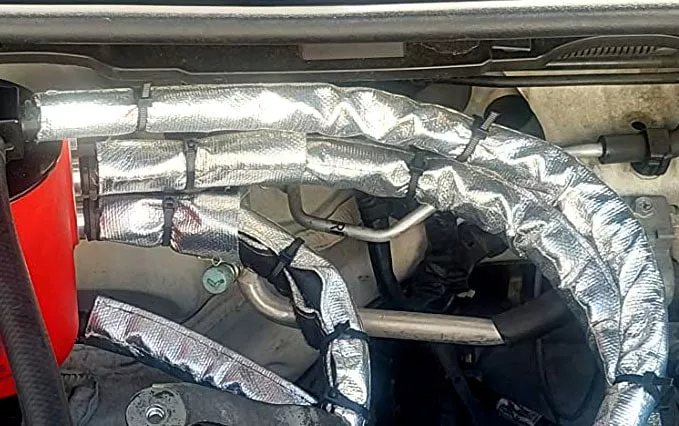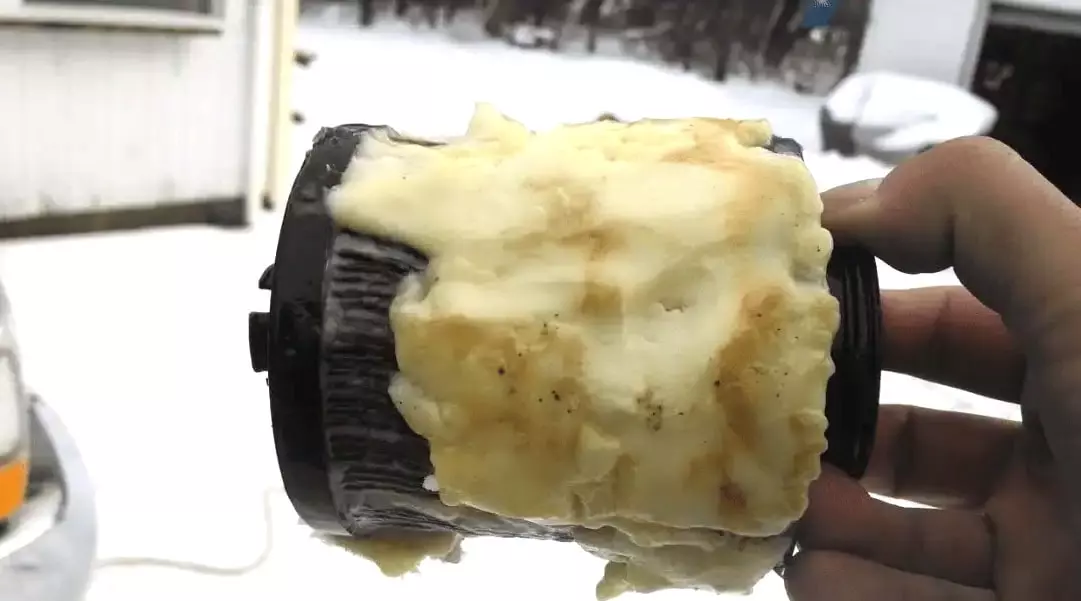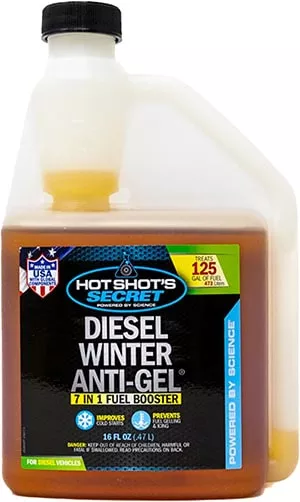When it’s getting cold, the diesel in diesel heaters tends to gel up, which, in turn prevents your diesel heater from working properly. Ideally, the diesel in your heater should always be a liquid.
In this article, we’ll have a look at 4 simple ways to prevent diesel gelling in your diesel heater when it’s cold.
How to Fix Diesel Heater Fuel Gelling
To properly winterize your diesel heater, you can protect your diesel on 3 different levels:
- chemical: using additives and fuel mixes
- physical: by adding insulation
- electrical: by adding supply heat
1. Diesel Anti-Gel Additive
One of the most effective ways to prevent diesel fuel from gelling in cold weather is by using a diesel anti-gel additive. These additives are specifically formulated to lower the freezing point of diesel fuel, ensuring it remains fluid even in lower temperatures.
How It Works:
Diesel anti-gel additives contain chemicals that interfere with the wax crystal formation in diesel fuel, which is the primary cause of gelling. By preventing these crystals from forming, the fuel maintains its liquidity.
One very popular diesel anti-gel additive is Hot Shot’s Secret Diesel Winter Anti-Gel (click to view it on amazon), which reduces fuel-line freezing temperature down to -40°F(!).
How to Use:
- Proper Measurement: The recommended ratio is typically mentioned on the product label. For most conditions, a mix ratio of one ounce of additive per five gallons of diesel is effective. In extremely cold conditions, you might need a stronger mix.
- Mixing with Fuel: It’s best to add the anti-gel additive to your diesel fuel before filling up your heater’s tank. This ensures thorough mixing.
- Timing: Add the additive before the onset of freezing temperatures for maximum effectiveness. If the fuel has already gelled, the additive might not work as well.
Regular Use in Winter:
Begin using the additive at the start of cold weather, before temperatures drop to the point where diesel fuel typically begins to gel. The ideal time to add anti-gel is whenever you’re refueling your diesel heater’s tank. Before filling the tank with diesel fuel, pour the recommended amount of additive directly into the empty tank.
2. Add Kerosene to Diesel Fuel
Mixing kerosene with diesel is a time-tested method to prevent fuel gelling in cold weather. Kerosene, with its lower gel point and viscosity, can significantly improve the cold-weather performance of your diesel heater.
And, it’s an alternative to using anti-gel, if kerosene is more accessible to you.
How It Works:
Kerosene remains fluid at lower temperatures where diesel would start to gel. When you mix diesel with kerosene, the result is a more winter-resistant fuel that ensures smooth flow and operation of your diesel heater.
How to Use:
- Mix Ratio: A common mix ratio is 80% diesel to 20% kerosene for cold weather conditions. However, the colder it gets, the more kerosene you should add. In extremely cold environments, a 50-50 mix might be necessary.
- Adding to Fuel: When refueling your diesel heater, first add the kerosene to the tank and then fill up with diesel. This order helps in mixing the two fuels more effectively.
- Quality Check: Ideally, use 1-K grade kerosene, which is cleaner and contains fewer impurities compared to other grades.
Considerations:
- Heater Compatibility: Check your diesel heater’s manual or with the manufacturer to ensure it’s safe to use a diesel-kerosene mix. Most heaters can handle this blend without issues, but it’s always good to confirm.
3. Use a 12V Heating Pad to Pre-Warm Diesel
Incorporating a 12V silicone heating pad into your diesel heater setup is an effective way to pre-warm the diesel fuel, especially in extremely cold environments.
This method directly combats fuel gelling by maintaining the fuel’s temperature above the gelling point.
These 20W silicone heating pads (click to view them on amazon) will work for this.
How It Works:
The silicone heating pad, when attached to the fuel tank or fuel line, pre-warms the diesel. This keeps it in a liquid state, preventing the formation of wax crystals that lead to gelling.
How to Use:
- Installation: Attach the heating pad to the outside of the diesel fuel tank or along the fuel line. Ensure it’s securely attached and insulated to maximize heat transfer.
- Electrical Connection: Connect the heating pad to a 12V power source. This can be the same battery powering the diesel heater or a separate one.
- Timing: Use the heating pad prior to starting the heater. Turn the heating pads off right before you start the heater. Otherwise your diesel heater might not receive enough electric power.
In cold conditions, keeping the pad on continuously or on a timer can ensure the diesel remains warm and fluid.
Considerations:
The biggest drawback of using additional heating pads to keep diesel warm is the constant energy consumption. The heating pads will drain your car battery over time.
So, they are not ideal. So, prefer using anti-gel or kerosene over using an additional heat source.
4. Insulate Fuel Lines
Fuel lines that are too cold can cause diesel to gel up while it’s being pumped into the heater.
This usually happens when you install the fuel line to pass through a colder part of your vehicle / space that you are heating.
For example, a fuel line that passes through an uninsulated part of your van / car / truck (outside the passenger space) will constantly expose diesel to the cold.
What to do:
Add some simple insulation to your fuel lines. It can be a simple insulation wrap or a special fuel line heat sleeve, specifically made to insulate fuel lines.
 Fuel line heat sleeves are perfect for fuel line insulation. But they only work well if the diesel is pre-heated and it passes through a cold space. If both tank and fuel lines are located in the cold, heat sleeves won’t help.
Fuel line heat sleeves are perfect for fuel line insulation. But they only work well if the diesel is pre-heated and it passes through a cold space. If both tank and fuel lines are located in the cold, heat sleeves won’t help.
The main downside of fuel line insulation is, in my opinion, that insulation obstructs the view of the fuel line. So, if you have transparent fuel lines, you can’t see the diesel flowing through the fuel line anymore.
A workaround, and even better than insulation, would be to completely restructure your fuel line setup and ensure it only passes through insulated space.
If it doesn’t work: Use Propane in Winter
These 4 strategies should ensure that the diesel in your diesel heater won’t gel up in winter.
If you still have diesel gelling problems, you can circumvent the issue, by using a different kind of heater during wintertime.
I recommend using propane heaters. Propane heaters are much more temperature-resistant than diesel heaters. Pressurized propane does not freeze anywhere near the humanly-endurable temperatures present on earth.
Conclusion
Effectively combating diesel fuel gelling in cold weather is crucial for the reliable operation of your diesel heater. By implementing the strategies discussed - using anti-gel additives like Hot Shot’s Secret, adding kerosene to diesel, employing 12V silicone heating pads, and insulating exterior-facing parts of the fuel lines - you can significantly enhance your heater’s performance in low temperatures.
Each method addresses a specific aspect of the gelling issue, from chemical prevention to physical protection.
Remember, the key to avoiding diesel gelling lies in proactive and preventive maintenance. By staying ahead of the problem and adapting to the challenges of colder weather, you can enjoy uninterrupted warmth and comfort from your diesel heater, regardless of how low the mercury drops.

